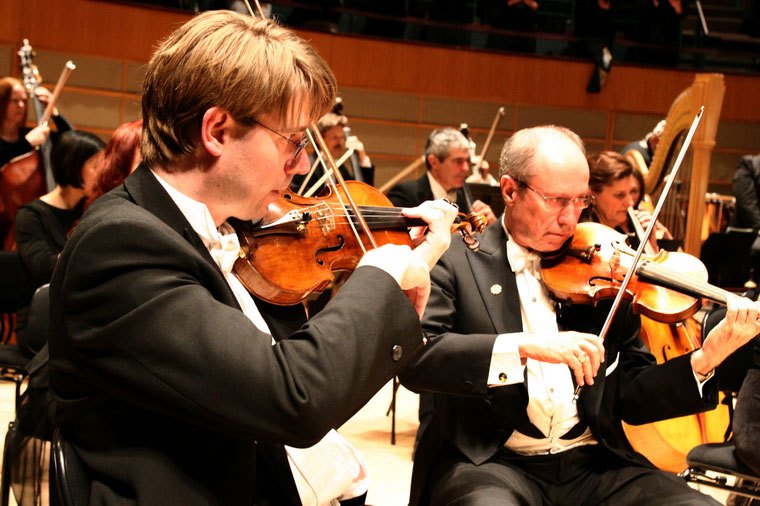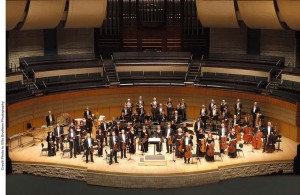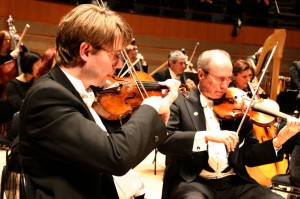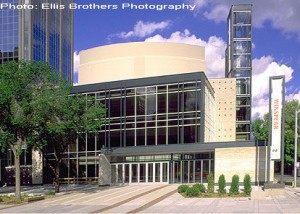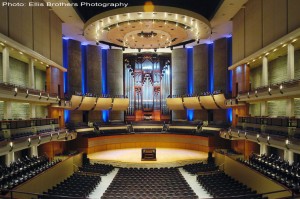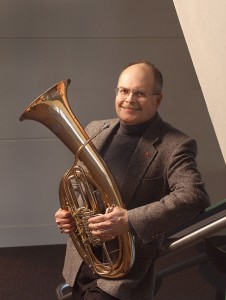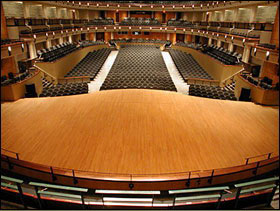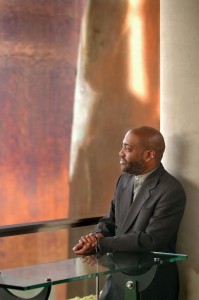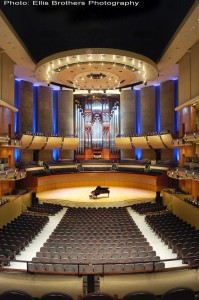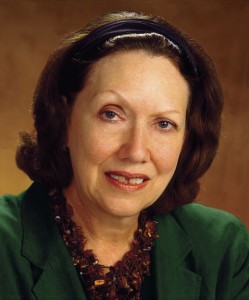Edmonton Symphony Orchestra
About The Ensemble
Most orchestra musicians probably haven’t given very much thought to the Edmonton Symphony Orchestra, but throughout recent years the ensemble has established itself as one of the most financially stable Canadian orchestras. Add to that a new music director, one of the most unique models of orchestra governance in the business, a discography of 23 recordings, and an acoustically superb dedicated orchestral concert hall and you begin to realize that the ESO is one of the most up and coming ensembles in North America.
To begin with, they are located 890 mi, or 1,432 km, from the Arctic Circle making the ESO the northernmost professional orchestra in North America. Their closest professional colleagues are the Calgary Philharmonic (184 mi/296 km) to the south and the Vancouver Symphony (718 mi/1,155 km) to the southwest. As such, it is not difficult to imagine the logistical challenges the organization faces with regard to attracting quality audition candidates and substitute musicians, as well as engaging in regional touring.
Nevertheless, don’t think that Edmonton is some artistic backwater. The greater metropolitan community is over one million and in 1997, The Francis Winspear Centre for Music opened for business with the ESO as one of their resident ensembles. Serving as the centerpiece for the Edmonton Arts District, the Winspear Centre shares space with the Edmonton Art Gallery, Edmonton City Hall, Citadel Theatre, and Stanley A. Milner Library.
Musician facilities include dedicated dressing rooms, five soundproof practice rooms, and eight instrument storage rooms, each with coded access. The 1,916 seat concert hall (which includes 216 seats in the choir loft behind the stage) features a classical rectangular European design. One of the hall’s centerpieces is the Davis Concert Organ which boasts 6,551 pipes and is the largest concert organ manufactured by Orgues Letourneau.
The ESO’s annual budget for the 06/07 season is right around CA$8 million (approximately US$7.1 million). They maintain a 291 services over a 41 week season and the annual base musician pay for the 56 contracted players is currently CA$41,000 (approximately US$36,538). However, the base salary will increase to CA$46,100 (approximately US$41,081) by the end of thier recently signed four year contract.
Perhaps an unusual aspect to U.S. orchestral musicians about the ESO collective bargaining agreement (CBA) is that there are no provisions for the organization to maintain a compliment of “B contract” musicians beyond the 56 core musicians specified in the CBA.
Instead, the ensemble retains what it defines as casual players, often referred to as substitute musicians in U.S. orchestras. Just like their U.S. peers, these musicians are used on an as-needed basis and they are not included in the CBA beyond minimum service payments. However, you’ll read more about how that has started to transform since the arrival of their new music director in 2005 later in this feature.
Perhaps for some, the most interesting aspect of the ensemble is its structure of governance which was adopted by the ESO board of directors following a work stoppage in 2002. This new form of governance provides the ESO musicians with a great deal of direct and indirect influence on how their board of directors takes shape. But you’ll learn more about those details in the interview with ESO 2nd horn and orchestra committee chair, Donald Plumb.
November 2006
An Interview With Donald Plumb, Edmonton Symphony Orchestra Committee Chair
Second Horn player, Donald Plumb, has been a member of the Edmonton Symphony since 1973. He currently serves as the elected orchestra committee chair along with serving on the ESO Board of Directors as one of the persons elected by the musicians.
Polyphonic.org Senior Editor & Research Principal, Drew McManus, spoke with Donald over the telephone about how the musicians are adjusting to recent changes in artistic leadership and playing an increased role in organizational governance.
Drew McManus: What is the average tenure for ESO players?
Donald Plumb: I would guess the average tenure here is higher than the average in other Canadian ensembles. As a result, we don’t have a lot of turnover, so one might call us a destination ensemble. Part of that low turnover may be due to geography; simply put, it’s harder to travel to other cities to take an audition. Edmonton is also a nice place to live, despite its latitude. There will be a big turnover in the next ten years as players retire.
Since a number of us have been around for so long, we know the community well and can give [the artistic administration] insight on what sort of programming we should offer the community.
Drew McManus: What sort of changes have you noticed throughout the organization since the arrival of your music director in the 2005-2006 season?
Donald Plumb: The biggest change is we now have clear artistic leadership. We went through a phase during the music director search with an artistic committee programming, which was somewhat generic. Since Mr. Eddins arrived, we have more of an individualistic artistic vision.
We still have five players that sit on an artistic advisory committee and they have a very cooperative relationship with Mr. Eddins and our Artistic Administrator, Rob McAlear. I would say that it is very helpful to have that artistic input within the organization.
is definitely not a stuffy, old-school conductor.” – Donald Plumb”]![“[Mr. Eddins] is definitely not a stuffy, old-school conductor.” Eddins_01_OS](http://www.esm.rochester.edu/iml/prjc/poly/wp-content/uploads/2011/09/Eddins_01_OS1-241x300.jpg) Mr. Eddins doesn’t talk to the audience at all concerts but when he does, it is well placed and equally well received. He is definitely not a stuffy, old-school conductor. He has an infectious personality and he is so enthusiastic about what he does and all of that comes across to the listener.
Mr. Eddins doesn’t talk to the audience at all concerts but when he does, it is well placed and equally well received. He is definitely not a stuffy, old-school conductor. He has an infectious personality and he is so enthusiastic about what he does and all of that comes across to the listener.
Of course, what really counts is substantive music making, and I think the balance between that and accessibility is good with Mr. Eddins. I think the concerts are truly exciting for the audience and the musicians enjoy being a part of that.
One of the risks you run into with so many long term players is repetition of repertoire. I think Mr. Eddins brings new perspectives to standard repertoire that offers us a way to work against the routine of repetition.
Drew McManus: What sort of artistic direction do you think the organization is moving?
Donald Plumb: Not surprisingly, we are doing more American repertoire than we’ve done in the past and even though we have always maintained a very strong commitment to Canadian works, including Canadian composers in residence, I have thought that our programming of U.S. composers has been a little lacking. Much of the music we’ve been performing since Mr. Eddins’ arrival is quite accessible, which I think helps audiences accept unfamiliar repertoire.

"I trust that various levels of government will always support the operations of orchestras to some extent...” – Donald Plumb
Hopefully, we will build a level of trust among the audience that will bring them into the hall confident that they will enjoy whatever we are playing even if they do not know the repertoire by name. Bill Eddins is particularly fond of Mozart. Our size orchestra and the responsive acoustics of the concert hall are well suited to Mozart. Bill has some interesting ideas for using internet technology and recordings to make the ESO more widely known. One benefit would be attracting more candidates for auditions.
Drew McManus: Where do you think the organization is financially?
Donald Plumb: We are fortunate to be in much better shape than some other Canadian orchestras. Even though we are doing well financially right now, I don’t think we’ll increase the number of core players above our current 56 in the near future, although I know we would be very happy if we had more strings. It would not be fiscally prudent to commit to expansion until it can be sustained indefinitely by a larger endowment fund. The acoustics of the Francis Winspear Centre for Music are so superior that full-size orchestra forces may never be needed to produce significant volume, but some more strings would warm the tone.
Drew McManus: Do you think Edmonton, and Canadian orchestra in general, will need to rely more on endowments as opposed to government support in the next 5-10 years?
Donald Plumb: I trust that various levels of government will always support the operations of orchestras to some extent, but significant philanthropic or corporate contributions to endowments are needed to grow orchestra organizations. We may be at a disadvantage in private or corporate fundraising of an inaccurate perception that we are sufficiently supported by government granting agencies alone.
Bill Eddins has emphasized the importance of building an endowment fund but our priority has, of necessity, been to eliminate the debt.
Drew McManus: The organization experienced a rough work stoppage in 2002, what sort of changes have taken place since then?
Donald Plumb:That unpleasant work stoppage taught us all that dialogue would have to be an ongoing component of organization health. Fundamental to settling the strike was creation of a five-person governance review committee with two nominees from the symphony society, two from the Edmonton Musicians’ Association, chaired by an arbitration lawyer acceptable to both sides.
Their in-depth study resulted in a report that recommended ways that we musicians could have significant influence within the organization. The ES Society readily accepted the concept of musician participation in governance. We musicians now elect three persons to the 18 person society board of directors. These are not just delegates, but full members and are not limited to musicians; they could be someone from the community that we feel would be an asset on the board. Another innovation is that musicians comprise a majority of persons – three out of five – on the board of directors nominating committee.
Other outcomes of the new governance model are is that musicians were very involved in the search for a new music director and we take part in a committee that reviews our conducting staff during their respective contract renewals.

“We have just extended our Agreement for four more years. This speaks to a mutual vote of confidence in the stability of the organization.” – Donald Plumb
I think we now have a much better culture of internal communication and I think we have a better idea of our mutual interests and shared sense of purpose. I know we received a lot of attention because of the strike, bad news travels fast, but I don’t know how much people realize how healthy we are now as a result of what came out of those events. I am not suggesting that one should go on strike to obtain similar outcomes, but a strike is a glimpse into the abyss that shows you there must be better ways to do things.
We have just extended our Agreement for four more years. This speaks to a mutual vote of confidence in the stability of the organization.
Drew McManus: What are some differences you think exist between being a musician in a Canadian orchestra as opposed to a U.S. ensemble?
Donald Plumb: My experience is limited to the Canadian scene. Perhaps the much larger number of orchestras in the USA creates more opportunities for career moves in increments up the ranks. There may be a greater sense of comradeship in being part of a larger musician community. In large population centers of the US, several orchestras might compete for the same classical music audience. This could be challenging but also stimulate an ensemble to stand out.
Another difference may be that we are one of a few Canadian orchestras where musicians are classified as self-employed contractors for income tax purposes. More professional expenses are deductible, but we do not qualify for employment insurance for 11 weeks in the summer without ESO income. This means we must budget our annual income for that interval without paychecks.
An Interview With Bill Eddins, Edmonton Symphony Orchestra Music Director
In the 2005/2006 concert season, conductor Bill Eddins assumed the role of music director for the Edmonton Symphony Orchestra. Upon embarking in that role, Bill stepped into an ensemble that recently came out of a bitter work stoppage with a newly adopted model of governance. However, the ensemble also had a number of inherent positives, not the least of which is the fact that they are a resident ensemble at one of the finest orchestral venues in the country. Polyphonic.org Senior Editor & Research Principal, Drew McManus, spoke with Bill over the telephone about his impressions after the first full year of service as well as where he sees the organization moving as an artistic force within Canada’s classical music scene
Drew McManus: Although this is your second season as music director, it’s your first with complete control over artistic planning. As such, where are you taking the ensemble?
Bill Eddins: Several months ago we were having an artistic programming meetings and our managing director told me she thought the programming that I was suggesting was boring. After looking at everything I could only agree that we could shake things up a bit and move away from the traditional “overture, concerto, symphony” route.
I ended up coming up with a concept called “Aspects” which is where I take an overall theme and see where that leads us with repertoire selections. “Music from the New World” is this season’s theme. Our first series of these concerts was in September, the theme might now be obvious to all our listeners. I write all of the program notes for the “Aspects” concerts so they have the same sort of insight into what we’re playing and why.
For example, the September concerts included works from featured Shostakovich [Age of Gold suite], Tchaikovsky [1st Piano Concerto], and Rachmaninoff [Symphonic Dances]. Usually one might look at that as an all Russian program. But if you take an audience through the steps of looking at it from a different perspective I hope they’ll begin looking at things differently and see why I think these are all pieces which fall under the theme of “Music from the New World”. So far, it’s too early in the season right now to see how successful we’ve been, but we’ll certainly find out at some point.
Drew McManus: Canadian orchestras are known for promoting new music from Canadian composers; as such, do you have any plans to increase programming music from U.S. composers?
Bill Eddins: Well, I’m a young American conductor so I do tend to program what I know. At the same time, Canadians are very sensitive with regard to issues of not allowing their neighbor to the south to become over-represented. I’ve both premiered and conducted several Canadian works in the short time I’ve been here, and I have at least one major commission on its way for 07-08 and another one in the works for 08-09. At the same time, I’ve been on a real Parisian kick lately so I’m including more from that genre too.
Drew McManus: Where do you see the ESO in the scheme of Canadian orchestras?
Bill Eddins: Edmonton is about three and a half steps from the Artic circle; I’m told you can even see the Aurora Borealis. [laughs] Seriously though, I hope Edmonton is in the lead when it comes to realizing we’re entering into a new millennium. There are three big budget orchestras in Canada that dominate the orchestral scene.
is one of the best pops orchestras I’ve ever conducted and they take great pride in this ability.” – Bill Eddins”]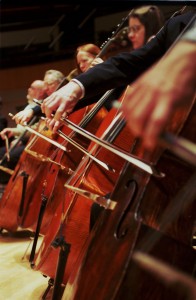 But I’ve found that bigger the organization is, the more difficult it is for them change. I call it the “Titanic Syndrome”, which doesn’t mean they don’t have the capacity for change but they have a much deeper entrenched sense of tradition that makes it more difficult for them to alter their course.
But I’ve found that bigger the organization is, the more difficult it is for them change. I call it the “Titanic Syndrome”, which doesn’t mean they don’t have the capacity for change but they have a much deeper entrenched sense of tradition that makes it more difficult for them to alter their course.
At [the ESO], we don’t plan our seasons several years in advance and the players are very willing to take chances. I also have to say that this ensemble is one of the best pops orchestras I’ve ever conducted and they take great pride in this ability. The result is that it’s really fun to play things like Gershwin which can be like pulling teeth with players in some other orchestras. I also think the group is better suited to taking advantage of new technologies and the new AFM recording agreement, which I hope we’ll be able to do in the near future.
Drew McManus: What sort of plans do you have in mind for taking advantage of that agreement? Are there any online endeavors in the works?
Bill Eddins: Nothing firm yet, we’re still figuring out the best way to go about this but I’m sure we’ll get it worked out. We can do it, but we have to spend the resources we have wisely; it needs to be “ready, aim, fire” instead of “ready, fire, aim”.
Drew McManus: Are there any plans for traditional recording?
Bill Eddins: There are plans for recordings but we’re not really concerned about the actual idiom, we just want to record music that shows the orchestra off at what we do best.
Drew McManus: Your contract is in year two of a three year agreement. Where do you see the group moving artistically before the end of your initial contract?
Bill Eddins: There are a couple of things I’ve been trying to emphasize: one of which is to improve our sense of ensemble, which I’m glad to say has shown great improvement since my time here. We need to be able to play with the sense of ensemble like a chamber orchestra but with 56 players.
Another change since I’ve arrived is initiating an audition system for substitute players – the Canadians call them casual players – which is the first time in the ensemble’s history this has happened. Part of the challenge is there is not an overabundance of extra players in the greater Edmonton area so we have to be very careful with selecting these additional players.
Drew McManus: Now that you’ve mentioned the size of the ensemble, 56 full time players, how exactly do you determine programming with a core that size and no B contract?
Bill Eddins: We have the advantage of residing in one of the best acoustical halls in Canada, which is a huge benefit because the group gets so much more sound out of the players we have without forcing them to play too hard.
At the same time, you do have to be careful because pieces which use a large number of wind, brass, and percussion players can still overpower the number of strings we use. Plus hiring a large number of extras for a concert can really skew the budget and we have to be careful of that. We have some limited stage space issues due to a movable choir loft that isn’t very mobile at the moment. That’s one particular issue I hope to see improve in the not-to-distant future. Our hall is celebrating it’s 10th Anniversary during the 07-08 season and there is a plan being considered to upgrade the performance chamber during that season.
Drew McManus: Once you get to fit more players on stage, will you program larger works?
Bill Eddins: Yes, but I only want to include additional players if we have the money for it. I would love to have nine additional string players but that will take extra resources. This all takes careful planning since it effects the budget of the orchestra on a long-term basis.
We’re just now getting out of a deficit environment so we’re starting to plan five year artistic goals and add up what sort of funds it will take to get there. As such, that approach will change how we do business, with conscious efforts to increase fundraising campaigns, gala events, etc. in order to fund these artistic improvements.
Drew McManus: Do you have discussions with the players about the artistic direction and how their influence on selecting board members can work to improve the organizations?
Bill Eddins: No to your second question, but I think that is a very good idea. But five of our musicians serve on the Programming Committee and that committee is very active, so their artistic ideas carry a lot of weight within the organization.
Drew McManus: Given its geographic location, how do you plan to get people to think that Edmonton isn’t some provincial artistic outpost?
Bill Eddins: I think it is a provincial artistic outpost, but not in a negative connotation. I’ve been amazed at how much cultural activity goes on in this town; there are three major art galleries and a fantastic theater. The ESO is one of the busiest orchestras I know because they also play for the Edmonton Opera and the Alberta Ballet. I think it is a highly cosmopolitan area chocked full Canadians, meaning that they are an outgoing, engaging people that care about the arts. It’s been an utter delight being among these folks.
The fact that they aren’t located close to another major metropolitan area has allowed them to develop a culture that is unique. As I mentioned before, it’s a new millennium and tools such as online formats and more are going to bring orchestras closer to their public regardless of geographic barriers so the old measures of quality, and success, are going to change.
An Interview With Elaine Calder, Edmonton Symphony Orchestra Managing Director
Elaine Calder joined the ESO as Managing Director in 2001 and Polyphonic.org Senior Editor & Research Principal, Drew McManus, spoke with Elaine over the telephone about what the organization has accomplished since she arrived and where she feels the organization is headed.
Drew McManus: What changes have you noticed throughout the organization since the arrival of your new music director?
Elaine Calder: Although I spent very little time with the previous music director, I would say he was very much a traditional Eastern European conductor – a “maestro” in every way – and Bill is a very different animal. Bill’s arrival has created a greater sense of excitement about the orchestra. He’s somewhat exotic by Edmonton’s standards and he’s incredibly good with the media; he understands the art of the sound byte. Bill is also very down to earth and very contemporary; we all appreciate that in him and so do our audiences.
Drew McManus: Artistically speaking, where do you see the ESO now and where do you think it is going?
Elaine Calder: There are three big budget orchestras in Canada: National Arts Centre Orchestra, Montreal Symphony Orchestra, and Toronto Symphony Orchestra. After that there are half a dozen regional orchestras and we feel very good about our position in that group. We pride ourselves on the fact that our players are the best paid musicians west of Toronto and even though we’ve weathered some severe storms, we didn’t close down. Similarly, although the players took freezes we didn’t have to make any salary cuts or eliminate players.
My entire time here has focused on three issues: find a new music director, get rid of the deficit, and build trust and cooperation between musicians, board, and management. Now that we have reached those goals, we’re experiencing a strange new freedom. It feels like the Czech Republic after the fall of communism. We have the chance to set our own destiny, and to be frank, we’re haven’t spent a lot of time on strategic planning in the last few years.

“Bill is also very down to earth…we all appreciate that in him and so do our audiences.” - Elaine Calder
So to begin with, we’re concentrating on Bill’s artistic vision, which includes expanding the core orchestra by nine additional string players. If, at any point in the upcoming four year contract, we can implement any improvements in numbers of players we’ll ask to reopen the contract.
We’re also striving to improve the players’ working conditions, which includes not overworking string musicians. Since we have a relatively small string section we are very sensitive about those issues. As a result, we have reinstated some medical benefits that had to be cut back during tougher times.
Drew McManus: How do you think the role of Managing Director best serves the organization?
Elaine Calder: I see my role here as someone who spends a fair amount of time making sure that the three major constituent groups really understand what the other groups are saying. For incoming board members and staff, the relationship between the groups can seem very unusual. I’m also here to inspire confidence in the community; after all, if the community is skeptical about the organization in any way they won’t want to support us.
And I think inspiring confidence inside the institution is critical. I’ve worked very hard at rebuilding our artistic confidence. We’ve improved service density, engaged musicians in scheduling and programming, and increased the number of rehearsals – all with a view to making it easier to make great music. In April 2005, we took the orchestra out of the province for the first time in 12 years. It was only two days but we made sure the players got first class treatment; going a bit beyond what the contract required us to provide.
Drew McManus: Are there any specific initiatives you would like to see transpire in the near future?
Elaine Calder: I would like to see us do more regional touring in upcoming years, especially to Fort McMurray, an oil town that has experienced tremendous growth in its working population. But distances between towns are great, which makes touring expensive and we’re starting to look for support from the oil companies that do business in the Fort McMurray area.
We are really very happy where we are right now, with our fabulous concert hall and with our new music director. We also have a splendid artistic administrator, Rob McAlear. He’s been instrumental in reversing our economic situation by making substantial artistic improvements in the quality of conductors and soloists we bring in.

“We’re also striving to improve the players’ working conditions, which includes not overworking string musicians.” - Elaine Calder
Rob loves programming for audiences and has insisted on implementing audience surveys when we weren’t moving in that direction. All of this has led to improved ticket sales and individual donations. Since he arrived we’re up 15% in cumulative ticket sales and 50% in individual and corporate donations.
Drew McManus: Is there anything else you would like to add that we haven’t touched on yet?
Elaine Calder: I’ve given my board notice that I’ll be leaving in the next few months, and we’ve started work on identifying my successor. I’ve been asked what the challenges will be for the new managing director and I’ve suggested they are both internal and external: internally, we have to make sure our new confidence and debt-free position don’t make us forget our inherent vulnerability, since we continue to operate very close to break even. Externally, the astounding wealth and growth of this province is making Edmonton a more attractive stop on national and international touring circuits, and our marketplace is becoming much more competitive.
It has taken a long time to restore the ESO to fiscal and artistic health, and a lot of people have participated in that process. We need to protect their investments – of time, money, intelligence and passion – and make sure we preserve and build on what we’ve accomplished.

